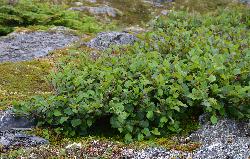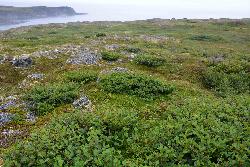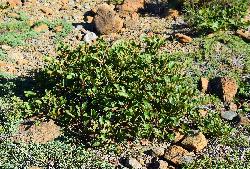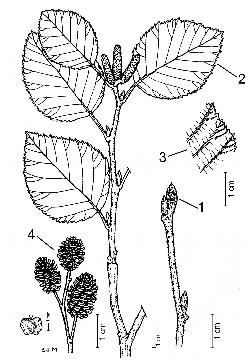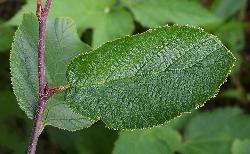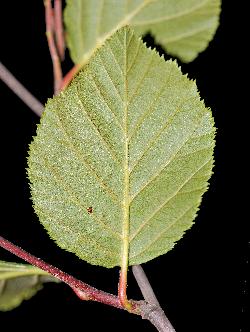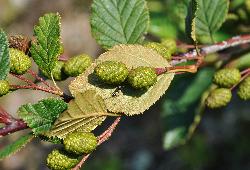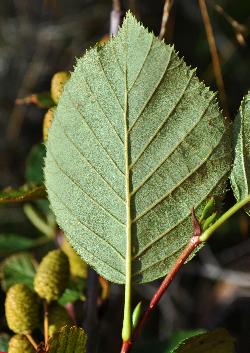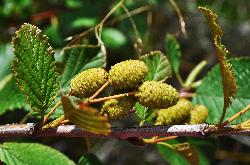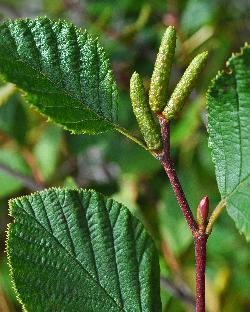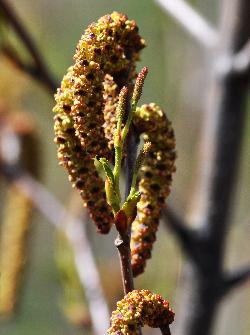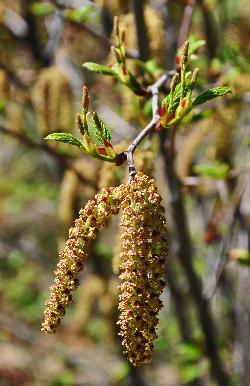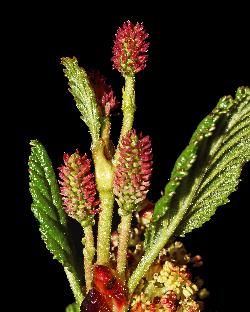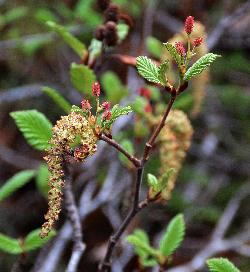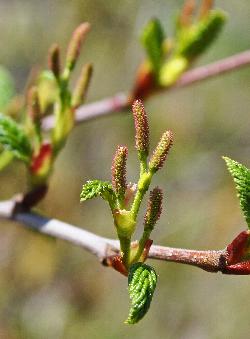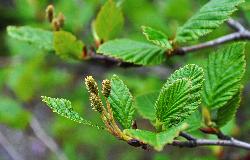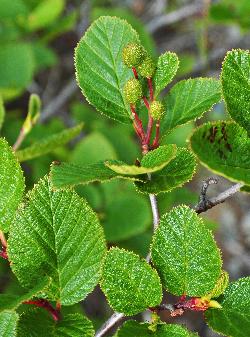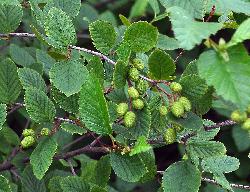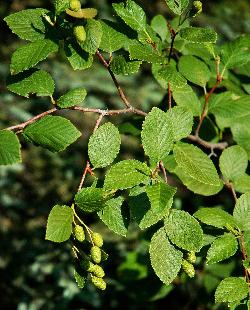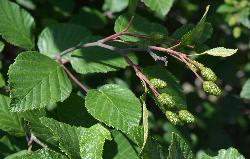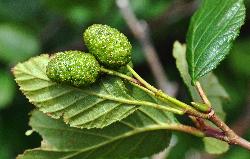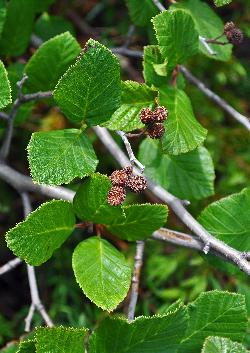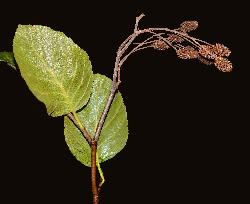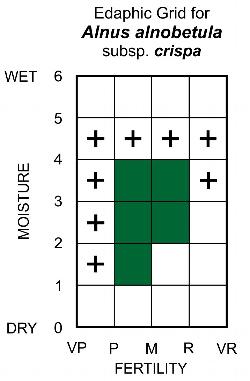Fr: aulne crispé, aulne tardif, aulne verte crispé, aulne de montagne, rame
IA: atushpi, uishakashk
Betulaceae - Birch Family
Note: Numbers provided in square brackets in the text refer to the image presented above; image numbers are displayed to the lower left of each image.
General: An open deciduous shrub, 0.5–3 m tall, with somewhat resinous branches and leaves [1–4]. Mountain alder is a shade-intolerant, shallow-rooted, pioneer species of dry upland habitats and scree slopes; its root nodules are capable of fixing nitrogen. The former species name of mountain alder, Alnus viridis (Vill.) DC. subsp. crispa (Aiton) Turrill, has recently changed. T. Raus (Greuter & Von Raab-Straube 2011) noted that this change was necessary because the species name Alnus alnobetula (Ehrh.) K.Koch has priority over Alnus viridis (Chaix) DC., and that the name A. viridis is actually a synonym of the Siberian alder, A. alnobetula subsp. fruticosa (Rupr.) Raus, native to northeastern Asia and western Canada.
Key Features: (numbers 1–4 refer to the illustration [5])
- Buds are sessile or nearly so, pointed (acute), with 4–6 shiny imbricate bud scales.
- Leaves are usually ovate, with rounded bases, acute apices, and finely biserrulate margins.
- Cross-veins between the secondary veins do not meet.
- Fruiting 'cones' are oblong and stalked, on 1–5 mm long peduncles.
Stems/twigs: Twigs are brown to reddish-brown and finely hairy, but become smooth with age (glabrate); the twigs are somewhat resinous and bear a few scattered pale lenticels; older stems are greyish-brown. Terminal and lateral buds are sessile, reddish-brown, ovate, pointed (acute) at the tip, and scaly, with 4–6 shiny overlapping (imbricate) bud scales [6–7]. Leaf scars are hemispherical with 3 bundle trace scars. Plants with leaves 4.5–10 cm long and persistent fine hairs on the twigs, lower leaf surfaces, and inflorescence peduncles were described by M.L. Fernald as Alnus mollis (Fernald 1904), now synonymized under subsp. crispa.
Leaves: Alternate, simple, pinnately-veined, and petiolate; petioles are 0.6–1.2 cm long. Leaf blades are firm, somewhat resinous, oval, broadly elliptic, ovate, or obovate [8–9], 3–10 cm long by 2.5–5 cm wide, dark green and glabrous above. The lower surface is slightly paler, often dotted with resin [10–11], or tawny due to resin-staining [12], and glabrous or somewhat hairy along the veins and in vein axils. There are usually 7–9 pairs of secondary veins along the midrib and the small cross-veins (tertiary veins) do not meet between the secondary veins [13]. Leaf bases are generally rounded to slightly cordate; the apex is usually pointed (acute), less often blunt (obtuse) to rounded. Margins are finely double-toothed (biserrulate) and flat at maturity, but are usually puckered or 'crisped' (with the edges tightly folded or pleated) when the leaves emerge [14–15], a feature that provided the source of the subspecies name crispa.
Flowers: Unisexual, plants monoecious, with numerous flowers arranged in male and female catkins (aments) borne on the same shrub. Male (staminate) catkins are terminal and over-winter as scaly catkins [16], about 1–2.5 cm long, rather than within buds; the catkins elongate to 3–9 cm when shedding pollen [17–18]. The smaller female (pistillate) catkins are narrowly cylindrical, long-stalked, erect, and have pinkish-red stigmas, clearly visible during anthesis [19]. Over winter, the developing female flowering catkins are enclosed within scaly lateral buds and emerge with the leaves in early spring [20–22].
Fruit: Immature fruiting catkins are ovoid and green to yellowish, with the scales tightly closed [24–28]. Mature fruiting catkins [23–30] are persistent, brown, woody, and cone-like, 1.2–2 cm long by 0.5–1.2 cm wide, and borne on long peduncles, 1–5 cm long, in clusters of 2–10 'woody cones'. The fruit are small 2-winged nutlets, 2–2.5 mm long, which are borne on the scales of the fruiting catkins; the lateral wings of the fruit are about as broad as the nutlet.
Ecology and Habitat: Mountain alder occurs throughout the forested regions of the province, as well as in barren landscapes above treeline in the mountains of northern Labrador and Newfoundland. Mountain alder is most commonly found on dry sites, particularly in lichen woodlands, but can occur on wet sites on the Avalon and Northern Peninsulas, where speckled alder is rare; in these conditions, mountain alder can form tall dense alder thickets [31]. Mountain alder is shade-intolerant and, due to its ability to fix nitrogen, is particularly well-adapted as a pioneer species on exposed soils and gravels in both primary and secondary succession. The leaves are very high in nitrogen and can rapidly improve the fertility and moisture retention of severely disturbed sites.
Edaphic Grid: See image [32]: the Edaphic Grid for Alnus alnobetula subsp. crispa.
Forest Types: Mountain alder is most frequently encountered on the following forest types:
- Abietum sphagnetosum (Sphagnum-Balsam Fir Forest Subassociation)
- Betuletum typicum (White Birch-Mountain Alder Forest Subassociation)
- Kalmio-Piceetum cladonietosum (Cladonia-Kalmia-Black Spruce Forest Subassociation)
- Kalmio-Piceetum typicum (Kalmia-Black Spruce Forest Subassociation)
Mountain alder can also occur sporadically in canopy gaps in black spruce and balsam fir forests, occupying sites with shallow soil or on exposed bedrock.
Succession: Mountain alder is shade-intolerant and only occurs in canopy gaps created by blowdown or in naturally-open woodlands and swamps. Its primary means of reproduction is by wind-dispersed seed, although it can recover from cutting and fire by sprouting from the root crown (Matthews 1992}. Mountain alder is a pioneer species that readily establishes on bare soils. Its nitrogen-fixing ability makes it particularly well-adapted to primary succession in areas of glacial recession or avalanche scars in mountainous terrain. It can also be an important species in the recovery of forests where the forest floor is destroyed by major disturbances, such as after severe fires or bulldozing. Unlike speckled alder, mountain alder is rarely a problem for forest regeneration after cutting. In fact, in some heathland afforestation trials on the Avalon Peninsula, naturally invading mountain alder in the plough furrows have been beneficial in providing shelter and nutrition to severely exposed plantations.
Distribution: Mountain alder is a boreal species that occurs throughout Newfoundland and Labrador. Its range extends from the east coast of Canada west to Alberta and north to the Northwest Territories and Nunavut. In the United States, it occurs from Maine through New England to upper New York, and in Midwestern States that border Lake Superior (Furlow 1997).
Similar Species: Speckled or tag alder (Alnus incana (L.) Moench subsp. rugosa (DuRoi) R.T. Clausen) is similar to mountain alder, but is easily distinguished by several characters. Speckled alder has leaves that are more coarsely toothed, with small cross veins that join in a ladder-like fashion between secondary veins, woody fruiting 'cones' that are sessile or short-stalked, and buds that are stalked, dull, and blunt at the tip. Also, female catkins of speckled alder are not contained within winter buds, but are borne naked, a short distance behind the male catkins on the same branches.



